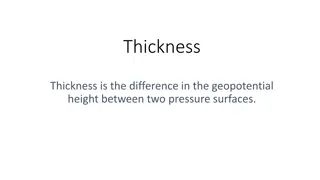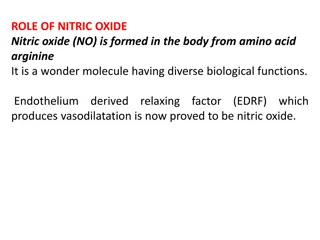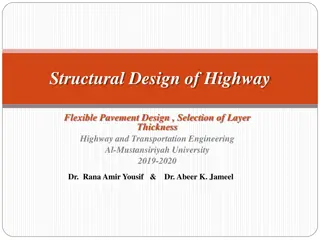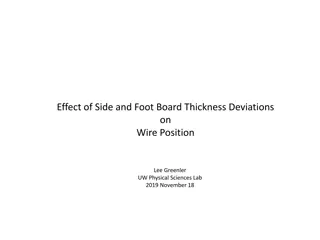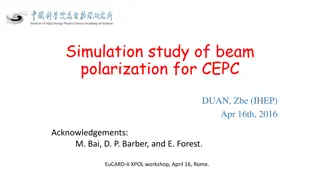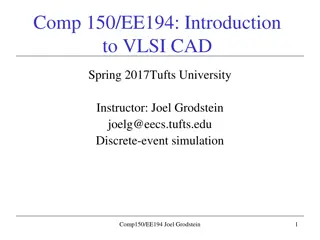DEPFET Internal Amplification vs. Oxide Thickness Simulation Study by Rainer Richter
The study explores the behavior of DEPFET internal amplification in comparison to oxide thickness through simulations conducted by Rainer Richter at the MPG Halbleiterlabor workshop. It delves into the differences in behavior between DEPFET and classical MOS transistors, shedding light on the reasons behind the unique linear response of DEPFET to charge at the internal gate. The content discusses the geometrical reasons behind this behavior, providing insights into the internal workings of DEPFET technology.
Download Presentation

Please find below an Image/Link to download the presentation.
The content on the website is provided AS IS for your information and personal use only. It may not be sold, licensed, or shared on other websites without obtaining consent from the author. Download presentation by click this link. If you encounter any issues during the download, it is possible that the publisher has removed the file from their server.
E N D
Presentation Transcript
DEPFET Internal amplification vs Oxide thickness Simulation Study Rainer Richter for the MPG Halbleiterlabor 1 7th PXD/SVD Workshop, Prague, January 2015 Rainer Richter, MPG Halbleiterlabor
Motivated by the nice results of Florian Krasser and Stefan Rummel If reality is behaving better than theory 2 7th PXD/SVD Workshop, Prague, January 2015 Rainer Richter, MPG Halbleiterlabor
Classical MOS-Transistor Scaling of all dimensions Transistor performance benefits from thinner gate oxides - larger gm - and less pronounced short channel effect Why is the internal amplification of a DEPFET behaving differently? gq ~ tox1/2 (Id = const.) 3 7th PXD/SVD Workshop, Prague, January 2015 Rainer Richter, MPG Halbleiterlabor
Classical MOS FET - Saturation (Basics) Vgate I = q/t Vsource Vdrain Either by many slow moving charge carriers or by fewer fast moving carriers carrier velocity v = E until velocity saturation ~107cm/s (in silicon) is reached Vpinchoff = V drain = Vgs Vth For Vdrain > Vpinchoff - > saturation ? ? ??? ?? 2 Id = ? Why is it quadratic? Q = Cox Vgs (linear) ideal transistor theory: V drain = Vgs - increased Vgs influences more channel carriers - V drain is pulled capacitively by Vgs provides more field 4 7th PXD/SVD Workshop, Prague, January 2015 Rainer Richter, MPG Halbleiterlabor
By the way Why has a DEPFET a nice linear response to the charge at the internal gate? If external gate and internal gate are acting in the same way . 5 7th PXD/SVD Workshop, Prague, January 2015 Rainer Richter, MPG Halbleiterlabor
By the way Why has a DEPFET a nice linear response to the charge at the internal gate? If external gate and internal gate are acting in the same way . Vgate Vsource Vdrain Internal Gate V drain Geometrical reason: The internal Gate is far away from the pinch off point and has much less capacitve coupling to it than the external Gate internal Gate is just influencing channel carriers (linear) 6 7th PXD/SVD Workshop, Prague, January 2015 Rainer Richter, MPG Halbleiterlabor
Back to the topic Vgate Vsource Vdrain Internal Gate V drain smaller tox -> larger Cox -> less Vgs is required to influence charge carriers in the channel less Vgs -> less V drain (lower field) -> lower carrier velocity Signal charge (internal Gate) influence the same amount of mirror charge in the channel but channel charge is moving slower -> less signal (Ramo, Shockley) 7 7th PXD/SVD Workshop, Prague, January 2015 Rainer Richter, MPG Halbleiterlabor
Simulations and measurements Why is the measured gq vs tox dependancy weaker than the predicted one? 2D device simulations (DIOS, SPROCESS, TeSCA) Change between 100nm and 200nm 14% Measurements: tox = 195nm, gq = 870pA/e- tox = 100nm, gq =780pA/e- (100 A, L=5 m) (F. Krasser, Master Thesis) -> 10% 8 7th PXD/SVD Workshop, Prague, January 2015 Rainer Richter, MPG Halbleiterlabor
Simulation results W =12 m, Ldesign=5 m The thinner the oxide the higher the electric field along the channel (in agreement with the simple theory) 9 7th PXD/SVD Workshop, Prague, January 2015 Rainer Richter, MPG Halbleiterlabor
But what is the reason for the better behavior? difference of the channel pot. in two states: Vdiff = Vch@100 A - Vch@100 A + 0.5V ideal transistor theory requires for the pinch off point V drain = Vgs V drain < Vgs The coupling is much smaller than 1 (especially for thicker oxides) The pinch off point is coupled also to the Drain (not considered in the simple theory) The answer: for thicker oxides a higher carrier velocity is achieved but the gain is not as high as predicted by the simple transistor model 10 7th PXD/SVD Workshop, Prague, January 2015 Rainer Richter, MPG Halbleiterlabor
Conclusions The gq vs tox measurements performed by Florian Krasser and Stefan Rummel can be confirmed and may be explained by device simulations. Reason for the measured deviations to the simple theory : Theory overestimates coupling between Vgate and V drain (pinch off point) Especially for thicker oxides the channel carrier velocity is lower than expected -> reduced Gq Changing the point of view ;-) before: we loose less Gq (than expected) when reducing the oxide thickness now: we don t gain so much (as expected) in Gq when increasing the oxide thickness 11 7th PXD/SVD Workshop, Prague, January 2015 Rainer Richter, MPG Halbleiterlabor




